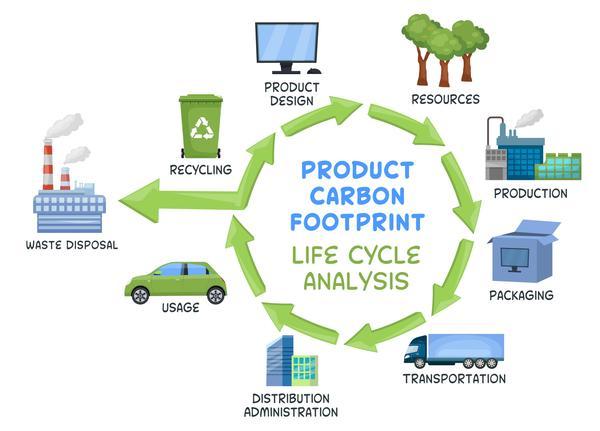What is a life cycle analysis (LCA) - Research and bibliography
The carbon emissions of associated with any item is normally expressed as KgCO2 Eq (equivalent) and is calculated by a technique known as a life cycle analysis (LCA). A LCA is a very helpful tool that can be applied to healthcare products as a means of calculating which product is more environmentally impactful. It is especially useful following the rise in single-use devices following the Covid-19 Pandemic. Equally it can assist healthcare professionals in making a more sustainable choices in their clinical practice. With regards to Orthopaedic Surgery this technique is commonly employed in the comparison of 2 products and their respective emissions or provides the granular methodology to calculate the total emissions associated with a specific procedure. When the estimated emissions of all products used in that procedure are tallied up.

A LCA is a method of calculation used to facilitate the quantification of material and energy inputs and outputs in one cycle of a products life within a defined system.
The LCA process is split into four phases, the first phase outlining study objectives and scope. This looks at what type of life cycle and the stages of the cycle that are included in the calculation, such as extraction, production, transportation, use and disposal. This is of particular importance in Trauma & Orthopaedic Surgery when we consider our reliance on single use items such as drapes, gowns and implants/components which will encompass all 4 of the aforementioned phases.
The second phase, life cycle inventory analysis (LCIA), compiles and quantifies the inputs and outputs of each process in production. It is complex and usually relies on the employment of established LCA data sets which contain granular and region-specific data. Following this is a life cycle impact assessment, which looks at the impact categories and the potential contributions made towards this. This typically looks at energy and material flows in the inventory. With a focus on Orthopaedic Surgery, the majority of our items are metal based which carries an extraction cost, or petroleum based plastic products.
Finally, the LCA and LCAI are interpreted and evaluated in the context of the study’s goal and scope to determine what effects a single life cycle will have on the environment. The scope of a LCA is set by defining system boundaries, data categories and explicitly listing the processes, inputs and outputs included in the calculation.
There two scopes utilised in a life cycle analysis calculation are “cradle-to-grave” and “cradle-to-cradle”.
Cradle-to-grave is the term used to describe the life cycle of single-use devices. Cradle-to-cradle is used when discussing reusable products. In this scenario, the number of times a single product is used is involved in the calculation. In addition to the effect of sterilization.
Finally, a functional unit is needed in an LCA study as a basis of comparison which is necessary to assess different products that carry out the same function and hence determine which product is more environmentally impactful.

Scope of life cycle assessment for a study comparing sutures vs skin clips
Life cycle analysis research - Bibliography
Operating in a climate crisis: A state-of-the-science review of life cycle assessment within surgical and anesthetic care
Full Reference:
Drew J, Christie SD, Tyedmers P, Smith-Forrester J, Rainham D. Operating in a climate crisis: A state-of-the-science review of life cycle assessment within surgical and anesthetic care. Environ Health Perspect. 2021;129(7):76001. Available at: https://doi.org/10.1289/ehp8666.
Key topics:
- Climate crisis + effects of COVID-19
- LCA definition
- Link between health care and global health
- Reason we are looking at surgeons
Environmentally responsible hand surgery: Past, present, and future
Full reference:
Bravo D, Gaston RG, Melamed E. Environmentally responsible hand surgery: Past, present, and future. J Hand Surg Am. 2020;45(5):444-8. Available at: https://doi.org/10.1016/j.jhsa.2019.10.031.
Key topics: Why are we looking at surgeons?
People, planet and profits: The case for greening operating rooms
Full reference:
Kagoma Y, Stall N, Rubinstein E, Naudie D. People, planet and profits: The case for greening operating rooms. CMAJ. 2012; 184(17):1905-11. Available at: 10.1503/cmaj.112139.
Operating room greening initiatives—The old, the new, and the way forward: A narrative review
Full reference:
Wyssusek KH, Keys MT, van Zundert AAJ. Operating room greening initiatives—The old, the new, and the way forward: A narrative review. Waste Manag Res. 2019;37(1):3-19. Available at: 10.1177/0734242X18793937
Sustainable healthcare waste management in the EU Circular Economy model
Full reference:
Full reference:
Sustainable healthcare waste management in the EU Circular Economy model Available at: https://noharm-europe.org/documents/sustainable-healthcare-waste-management-eu-circular-economy-model.
Key topics:
- sustainable healthcare
- waste management
- circular economy
- position paper
“Midpoint, endpoint or single score for decision-making?”
Full reference:
Kägi T, Dinkel F, Frischknecht R, Humbert S, Lindberg J, Mester S, et al. Session “Midpoint, endpoint or single score for decision-making?”— SETAC Europe 25th Annual Meeting, May 5th, 2015. Int J Life Cycle Assess. 2015;21:129-32. Available at: https://doi.org/10.1007/s11367-015-0998-0.
Key topics:
- Life Cycle Impact Assessment Method
- Product Environmental Footprint
International comparison of health care carbon footprints
Pichler PP, Jaccard IS, Weisz U, Weisz H. International comparison of health care carbon footprints. Environ Res Lett. 2019;14:064004. Available at: https://dx.doi.org/10.1088/1748-9326/ab19e1.
The direct environmental impact of hip arthroscopy for femoroacetabular impingement: a surgical waste audit of five cases
Full reference:
de SA D, Stephens K, Kuang M, Simunovic N, Karlsson J, Ayeni OR, The direct environmental impact of hip arthroscopy for femoroacetabular impingement: a surgical waste audit of five cases. J Hip Preserv Surg. 2016;3(2):132-7. Available at: 10.1093/jhps/hnv085.
